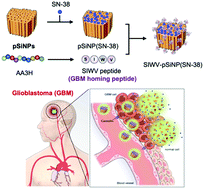Organ-specific cell-penetrating peptides (CPPs) are a class of molecules that can be highly effective at delivering therapeutic cargoes, and they are currently of great interest in cancer treatment strategies. Herein, we describe a new CPP (amino acid sequence serine-isoleucine-tyrosine-valine, or SIWV) that homes to glioblastoma multiforme (GBM) brain tumor tissues with remarkable specificity in vitro and in vivo. The SIWV sequence was identified from an isoform of annexin-A3 (AA3H), a membrane-interacting human protein. The mechanism of intracellular permeation is proposed to follow a caveolin-mediated endocytotic pathway, based on in vitro and in vivo receptor inhibition and genetic knockdown studies. Feasibility as a targeting agent for therapeutics is demonstrated in a GBM xenograft mouse model, where porous silicon nanoparticles (pSiNPs) containing the clinically relevant anticancer drug SN-38 are grafted with SIWV via a poly-(ethylene glycol) (PEG) linker. The formulation shows enhanced in vivo targeting ability relative to a formulation employing a scrambled control peptide, and significant (P < 0.05) therapeutic efficacy relative to free SN-38 in the GBM xenograft animal model.
